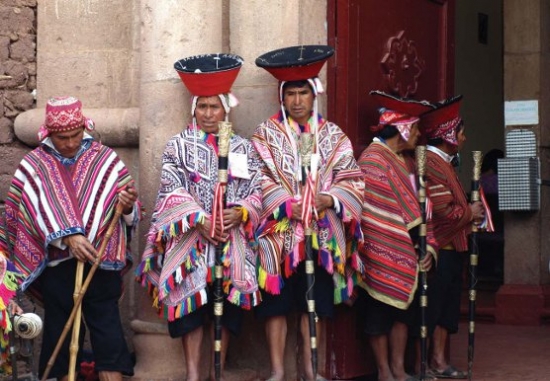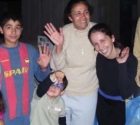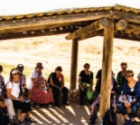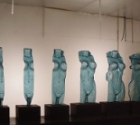
The Sacred Valley-Inca tradition meets Catholic Church.
Wonderful pictures of Machu Pichu sitting majestically above the green jungle and exciting stories about the handsome, brave Incas with their mountains of gold, had, for as long as I can remember, made Peru the destination of my dreams in South America. However, while I have been "unfearingly" visiting the Far East, almost on a yearly basis, for the past 25 years, there was always some excuse that allowed me to postpone my trip to Peru. Even after admitting to myself that the excuses were pretty weak, I still managed to find a reason why we would go the following year, but that this year we would go somewhere else. Eventually I ran out of excuses and booked plane tickets for my wife, my two youngest children and myself. I booked the tickets about nine months in advance, working on the assumption that as it is still such a long time away, my inexplicable anxiety level would still be low, and by the time the date of departure arrived it would be too difficult and too embarrassing to cancel. (In reality, three weeks before the trip I tried to change our destination to Brazil.)
Part of my anxiety about a trip to Peru was related to the problem of altitude and the effect it would have on us. We had been to a height of almost 4,000 meters on previous trips with no complications but now the ascent would be less gradual, we were older and we would be going over 5,000 meters. I planned the trip with "rest" days in order to allow us to acclimatize and hopefully prevent any problems. A second problem I worried about was the possibility of violence, a fact of life in so many of the South American countries and a side of Peru and Bolivia that I had been repeatedly warned about by other travelers. I am sure that having read this far, you are biting your nails in anticipation of the problems we would encounter. Relax, everything worked out wonderfully and we had no problems at all.
Lima with its limited tourist sights, but good food, was the start of our trip. Sitting on the veranda of a restaurant in a luxurious shopping center on the edge of a cliff overlooking the sea, we had a delicious meal while people braver than I glided above and below us on colorful hang gliders, coming almost to within touching distance. My son was enthralled but less so than by the waitresses serving at "Hooters", another restaurant in the same complex.
We took an overnight bus to Arequipa, situated at about 2,400 meters and from where we planned to take a trip to visit the Colca Canyon, supposedly one of the deepest canyons in the world and famous for its giant condors, which ride the thermals in the early morning, circling round and round while they rise higher and higher into the sky. The condors are enormous birds with a wing span of over three meters and if the lion is the king of the beasts then surely the condor is the king of the birds. As with all game viewing, it's a matter of luck. We saw one pair right near us and another further away. Reasonable, but we would have liked to have seen more. The two-day trip to the canyon required crossing a pass of over 5,000 meters where we stopped to look at the unique flora found only at these heights. Eating coca sweets and drinking coca tea were recommended to us by the guide as a proven way of preventing altitude sickness. We did both and we had no problems which unequivocally proves that either they work or that had we not had the coca, we would have felt fine anyway. Coca leaves are the leaves that cocaine is made from and are chewed together with a small piece of ashy stone. The wad of leaves is then kept between the teeth and the cheek and the alkaloid that is released helps prevent altitude sickness, tiredness, thirst and no end of other problems. We stopped at small souvenir stalls on the way, where colorfully clothed women and children, some dragging a lamb or lama behind them in the hope of having their picture taken and thereby earning a few cents, were selling local handicrafts.
Arequipa itself is a pretty town which kept us busy for a couple of days. Most interesting were its fascinating monastery and Juanita, the Ice Maiden, a frozen, well preserved, 14-year-old girl, discovered on a mountain top in 1996. She was probably a human sacrifice made 600 years ago to appease the Inca mountain gods.
From Arequipa we once again took an overnight bus, this time to Cusco. (The overnight bus is fitted out like an airplane, with a regular and luxury class, where the seats recline to a bed and the steward brings you a meal.) We arrived at the main square, which is, as in all Spanish towns, the heart of the town, and Cusco has the most beautiful square I have ever seen. It was still early morning and there were hardly any people about, giving the square a sense of peace that would disappear later on in the day. I left my wife and daughter at a coffee shop with our backpacks, while my son and I set off to find a hotel. Cusco is built on the side of a hill, and while our map of the town showed us where everything was situated, it didn't show us how steep the roads were. Cusco is a delightful town and it would require no effort at all to spend a few weeks there, learning Spanish, taking hikes in the surrounding hills, visiting the markets and simply relaxing. Many reminders of the Inca period still exist, the most impressive of which are the walls built of enormous granite blocks, which are cut with such precision that they fit together perfectly, dispensing with the need for cement. It would be remiss of me to write about Cusco and not mention the wonderful food, which is almost always accompanied by beautiful Andean music played by groups of young men in the hope of receiving a small tip. There are steak houses, Italian restaurants and of course, if you so fancy, cue, which is a delicacy eaten in this part of the world. It is served roasted with the head and legs intact and its little teeth looking really sharp. Did I mention that the English word for cue is guinea pig? As adventurous as I am, eating guinea pig isn't for me.
Cusco was the Inca capital and we used it as a base for exploring the sacred valley, renting a car and driver one day, going by bus or train the next. We visited Pisac with its busy, colorful Sunday market, where we went to Mass at the local church, enthralled by the combination of Catholic church and colorfully dressed men and women in their traditional Sunday best. We visited Inca ruins in places with magical names. Urubamba. Ollantaytambo. The ruins are fascinating and we spent hours exploring them. Some are perched on the hillside high above the adjacent valley probably having been used as a military base, while others were of religious significance.
If I was given the chance to trek anywhere in the world, my choice would have to be the famous Inca trail to Machu Pichu. I had dreamed about walking along its tree covered paths and of suddenly turning a corner to see this fairytale city, built many hundreds of years ago, there in front of me. But dreams don't always become reality, well not completely at any rate. Today, trekking the Inca trail can only be done with an organized group and must be booked months in advance, as only a certain number of people are allowed on the trail at any one time. Our time limitation plus the cost for the four of us caused us to choose the shorter and cheaper (not cheap) but less romantic alternative, of getting to Machu Pichu by train and bus. We spent the night before at Aguas Calientes (Hot Waters), a small town below Machu Pichu, which can only be reached by train. Five in the morning saw us bleary-eyed at the bus stop with at least a hundred other people waiting for the bus to the ruins. It is necessary to be at the ruins as early as possible if one wants to climb Huayna Picchu, the mountain behind the ruins, as on this trail as well, only a limited number of people are allowed each day. The view from the top was awe-inspiring, but only after we had waited for an hour or so for the clouds to drift away, slowly revealing the ruins suspended between the mountains below us and the forested valley floor, a long way below them. On returning to the ruins we took a guide (actually it turned out that she had borrowed the "official guide" identity card from her cousin who was taking the day off) to show us around. By now the ruins were pretty much overrun with tourist groups and the mystery that we felt in the chilly early morning air had pretty much disappeared. However its grandeur was unmistakable and only complete physical exhaustion and the impending departure of the last train back to Cusco, forced us to catch the bus back down to Aguas Calientes. What a day!
On to Puno, a town on the shores of Lake Titicaca. The lake is beautiful and is famous for its floating islands. About 1,500 people live on the numerous islands that are built out of reeds. The base of the island is built out of a block of the reed root which floats. Bundles of reeds are then placed on top of this and people build houses out of reeds on top of this spongy floating island. Reed boats were once a common sight on the lake but modernization has come to Titicaca too, and most of the people now use a dugout canoe. My children went off on a two-day trip to the various islands on the lake, overnighting with the locals, while we settled for a one-day trip and Yom Kippur in Puno. Trout are farmed in the lake and can be eaten at one of the restaurants in town for a few shekels, cooked any way you choose or even uncooked as ceviche, fresh raw fish marinated in lime juice and chilies, and popular all over Peru. My favorite ceviche place was a small stall in the market in Puno which had been recommended by some locals.
Lake Titicaca is on the border between Peru and Bolivia, and so, regretfully, we boarded an early morning bus which would get us to La Pas, Bolivia by late afternoon.
Often when one fantasizes about a place, the reality is disappointing. Peru is certainly not an example, and I am looking forward to going back to Cusco for a longer period – to try to absorb more of its grandeur and tranquility, to eat delicious Italian food and drink chicha, a local beer made of fermented corn. I will end now and go and sit on the verandah in an easy chair in the warm winter sun, and dream. Dream of those places in Peru that we didn't manage to see this trip – the famous Nasca Lines, the rainforest and hiking in the Cordillera Blanca.
 ESRA ASHKELON DONATED GOODS
ESRA ASHKELON DONATED GOODS  DEFIANCE TEL AVIV STYLE
DEFIANCE TEL AVIV STYLE  THE SPIRIT OF ESRA-JULES AND PERLA FOX- EXCEPTIONAL BENEFACTORS
THE SPIRIT OF ESRA-JULES AND PERLA FOX- EXCEPTIONAL BENEFACTORS From Bible to Bedouins and Battles
From Bible to Bedouins and Battles Trip to the Dead Sea
Trip to the Dead Sea Japan
Japan Brian Braude
Brian Braude